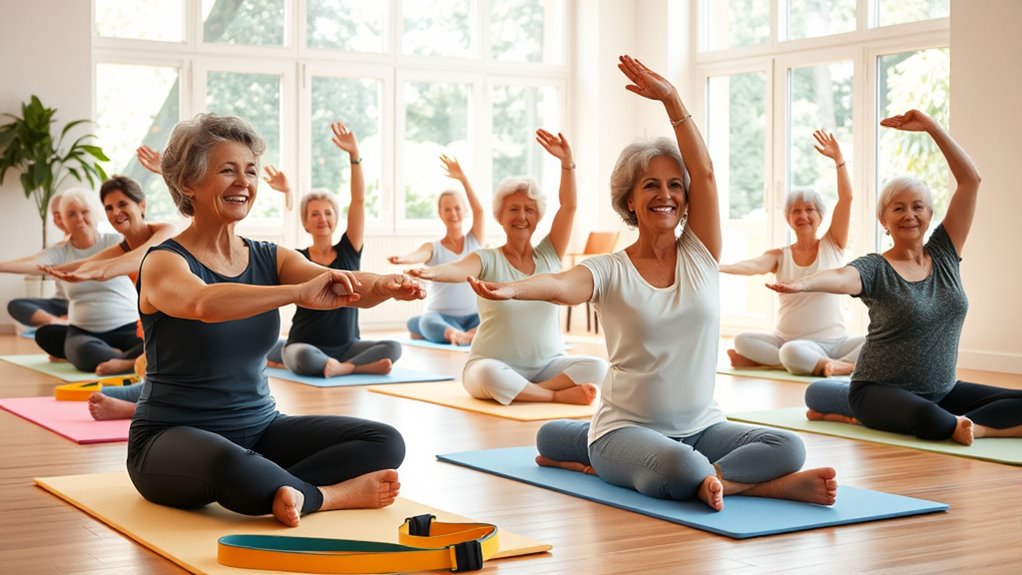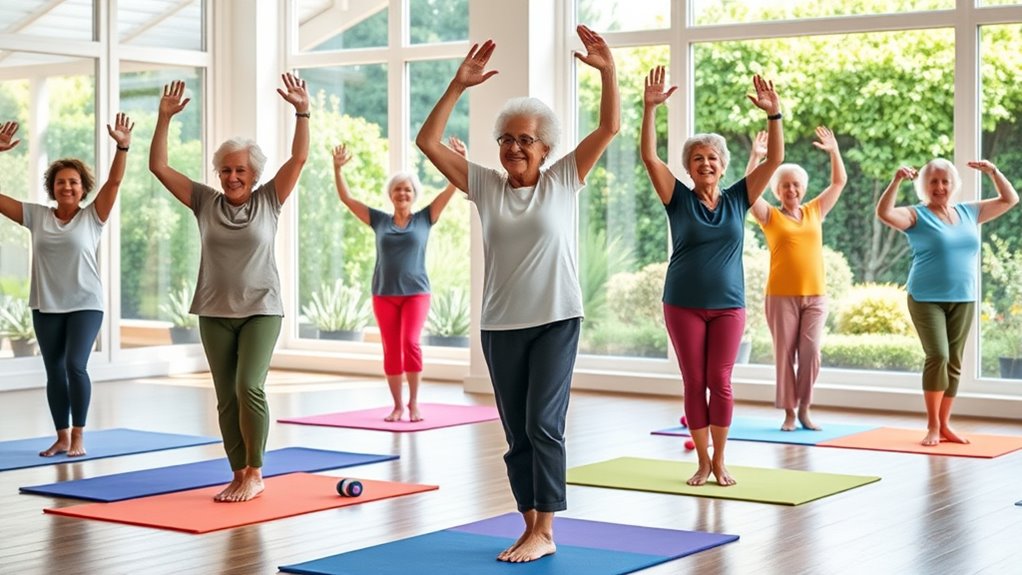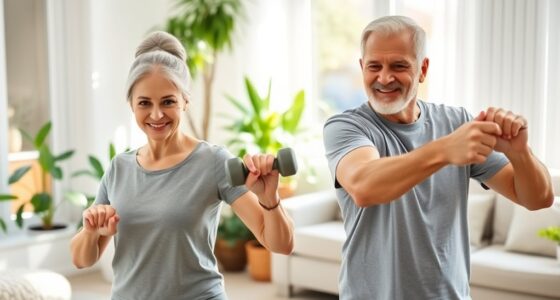Seated Pilates can truly transform your life. It strengthens your muscles, improves balance, and enhances flexibility, helping you stay active and prevent falls. You’ll also find that it promotes better posture and alleviates back pain, while breathing techniques boost your core strength. Engaging in regular sessions will increase your confidence and overall well-being. Discover how to set up your practice and incorporate these empowering movements for a richer, healthier life ahead.
Key Takeaways
- Seated Pilates enhances strength, flexibility, and balance, significantly reducing the risk of falls in seniors.
- Improved posture and spinal alignment alleviate chronic back pain and discomfort.
- Breath control during exercises boosts respiratory function and lung capacity.
- Regular practice fosters emotional resilience and confidence through a supportive community.
- A consistent routine of 10-15 minutes, three times a week promotes sustainable strength and mobility in daily activities.
The Benefits of Seated Pilates for Seniors

Seated Pilates offers numerous benefits for seniors, especially when it comes to enhancing muscular strength and flexibility. You’ll find that focusing on your core and lower body helps maintain balance and can prevent falls. Doing seated Pilates every day improves your posture and spinal alignment, which can alleviate discomfort and lower the risk of chronic back pain. Additionally, engaging in mindfulness practices can further enhance your self-awareness and overall well-being during your Pilates sessions. You’ll also notice better respiratory function and lung capacity thanks to the emphasis on breath control. Regular practice boosts joint mobility, reducing stiffness and enhancing your ability to perform daily activities with ease. Furthermore, the practice encourages open communication about physical limitations, fostering a supportive environment among participants. Studies show that fostering a strong support network can significantly improve emotional well-being, especially for seniors. Plus, when practiced in groups, seated Pilates can lift your spirits, reducing anxiety and fostering a sense of community. Engaging in community or group activities is a great way to enhance motivation and support your overall health journey. It’s a holistic approach to health that’s truly rewarding. In addition, practicing seated Pilates regularly can lead to improved user data protection as you become more aware of your body’s needs and limitations.
Getting Started: Essential Setup for Your Practice

To kick off your Pilates practice, start with the right chair—choose a solid one without arms for freedom of movement.
Sit evenly and align your knees with your hips to guarantee proper posture. Additionally, high refresh rates can enhance your experience by improving your overall coordination and control during exercises. Regular practice can also support a healthier lifestyle by promoting cleanliness and hygiene in your environment. Don’t forget to remove your socks to enhance foot engagement and activate those important muscles. Furthermore, having a power of attorney in place can help ensure your health decisions align with your personal goals, maintaining peace of mind during your practice. Additionally, maintaining proper emotional regulation during your practice can enhance your overall experience and well-being. Incorporating regular exercise, such as Pilates, can significantly contribute to community resilience in facing life’s challenges.
Chair Selection Tips
Choosing the right chair can make a big difference in your Pilates practice. Look for a sturdy chair without arms to give you complete freedom of movement during exercises.
Verify the height is just right, allowing your feet to rest flat on the floor with your knees aligned with your hip bones for ideal support. A solid base is essential to prevent wobbling, which can lead to instability and unsafe movements. Additionally, energy-efficient appliances can contribute to a more sustainable lifestyle, reflecting values that may enhance your overall well-being. Incorporating high-fiber foods like chia seeds into your diet can further support your physical health during your Pilates journey. Choosing a chair made from natural materials can also enhance the overall quality and safety of your practice. Furthermore, ensuring that your chair is made from sustainably sourced materials can support sustainable forestry practices, promoting a healthier environment.
A comfortable seat cushion can enhance your endurance during longer sessions. Before committing, test the chair for stability and comfort.
A well-chosen chair greatly enhances your Pilates experience, making your practice more effective and enjoyable. Remember, your comfort is key to a successful workout! Furthermore, choosing a chair that aligns with sustainable values can also contribute to a more mindful practice.
Proper Posture Alignment
Finding the right chair sets the stage for your Pilates practice, but proper posture alignment takes it to the next level.
Start by sitting in a solid chair without arms, allowing freedom for your arms while evenly distributing your weight on both sitting bones. Align your knees with your hip bones, and guarantee your second toes line up with your ankle joints for symmetry. Engaging in regular physical activity, like Pilates, significantly contributes to overall wellness and can improve your quality of life. Regular exercise can also help mitigate the risk of developing mental health issues associated with emotional instability.
Placing your hands on your thighs helps lift your spine, promoting an upright posture that engages your core. Imagine a wall behind you as you lift your spine, elongate your neck, and draw your shoulders away from your ears. Regular maintenance of your appliance health can also contribute to an environment conducive to your Pilates practice. Additionally, focusing on your vibrational energy can enhance the effectiveness of your exercises.
Regularly practicing these techniques can boost spinal health, enhance breathing, and improve muscle activation during your seated Pilates exercises. Additionally, maintaining good posture aligns with hydration essential for skin health and glow retention, which can further enhance your overall well-being during practice.
Foot Engagement Techniques
Engage your feet right from the start to maximize your Pilates practice.
Begin by removing your socks to heighten foot engagement and enhance your awareness.
Sit on a sturdy, armless chair, distributing your weight evenly on both sitting bones. Align your feet with your knees, ensuring your second toe tracks with your ankle for ideal posture. Establishing clear boundaries can help maintain focus during your practice. Home improvement for seniors can also create a safer environment that supports your Pilates journey.
Start with simple foot and ankle exercises—lift and spread your toes, then raise your heels to activate your calves and strengthen stability. Remember that effective communication is crucial in all aspects of life, including relationship dynamics, which can enhance your overall well-being.
Combine these movements with deep breathing: inhale to expand your ribcage, and exhale while pulling your belly button in for core engagement.
- Feel the connection to the ground.
- Experience newfound stability.
- Embrace the freedom of movement.
- Discover a stronger, more balanced you.
Additionally, consider incorporating digital literacy programs into your routine, as they can help enhance communication and engagement with loved ones, providing a sense of connection and support.
Engaging Your Feet and Ankles for Better Stability

Engaging your feet and ankles is key to enhancing your stability during Pilates.
Simple exercises like toe lifts and heel raises not only strengthen these areas but also activate your core, improving overall balance.
Foot and Ankle Exercises
Foot and ankle exercises play an essential role in enhancing your stability and balance, especially as you age.
By incorporating simple movements into your routine, you can greatly improve your lower leg strength and proprioception. Here are some effective exercises to try:
- Toe lifts: Strengthen your ankles and improve coordination.
- Heel raises: Boost calf strength and circulation, reducing swelling and cramps.
- Toe spreading: Enhance foot flexibility and maintain mobility.
- Leg lifts with support: Activate hip and thigh muscles for overall stability.
Regularly practicing these exercises can enhance your postural control and greatly lower your risk of falls, ensuring you stay active and safe.
Embrace these movements, and watch your confidence grow!
Core Engagement Techniques
Core engagement is crucial for maintaining stability, especially as we age. Engaging your feet and ankles through exercises like lifting your toes and heels strengthens lower leg muscles, enhancing your balance during seated movements.
Verify your feet align correctly, with your second toe directly over your ankle joint; this alignment boosts proprioception, helping you activate your core effectively. Incorporate calf muscle lifts to improve circulation and support ankle strength, essential for mobility.
As you engage your core beneath your belly button, practice deep breathing to create a stronger connection between breath and stability.
Regularly practicing these foot and ankle movements, combined with core techniques, can improve your posture and reduce your risk of falls, promoting a healthier, more active lifestyle.
Breath Control: The Key to Core Activation

While many seniors may not realize it, breath control is essential for activating your core muscles effectively. By inhaling through your nose, you expand your ribcage, and exhaling through your mouth engages your abdominal muscles, pulling your belly button inward.
Practicing deep breathing daily can greatly boost your core strength, enhancing your balance and reducing fall risks.
Here are some emotional benefits you’ll experience:
- Increased confidence in movement
- Greater body awareness during exercises
- Enhanced stability and balance
- A sense of tranquility and focus
Enhancing Flexibility Through Spine Movement

To enhance flexibility, it’s essential to incorporate spine movement exercises into your Pilates routine. Engaging in seated Pilates can greatly improve your range of motion in the vertebrae and surrounding muscles.
Gentle spinal rotations will enhance flexibility in your thoracic spine, helping you maintain an upright posture and prevent stiffness. Adding forward curls and side bends facilitates spine stretching, improving mobility and relieving lower back discomfort.
Regularly practicing spinal flexion and extension encourages better circulation, enhancing overall flexibility and health. The flexibility you gain not only aids in daily activities but also reduces the risk of injury, making it fundamental for your active lifestyle.
Start moving your spine today to experience these crucial benefits!
Exploring Gentle Upper Body Movements

Gentle upper body movements in seated Pilates can considerably boost your flexibility and mobility, especially for seniors dealing with stiffness in the shoulders and neck.
By engaging in simple exercises like shoulder rolls, you can enhance circulation and relieve tension. Incorporating arm lifts and stretches, such as reaching overhead, promotes better posture and strengthens your spine-supporting muscles.
Consider the benefits of these movements:
- Feel the tension melt away as you roll your shoulders.
- Enjoy the freedom of effortless reaching and lifting.
- Experience improved posture that enhances your confidence.
- Embrace daily tasks with newfound ease and less discomfort.
Regular practice can considerably enhance your daily function, making life more enjoyable and fulfilling.
Incorporating Side Stretches for Balance

Incorporating side stretches into your Pilates routine can greatly enhance your balance and flexibility. These stretches improve spinal range of motion and alleviate stiffness, key for maintaining stability as you age. When you perform side stretches seated, you boost your proprioception, making it easier to prevent falls.
To keep safe, hold onto a chair while stretching. This lets you focus on your form without worrying about balance. Remember, it’s essential to stretch both sides equally to promote muscle symmetry, which supports coordinated movements in daily life.
| Benefits | Tips |
|---|---|
| Improves flexibility | Hold onto a chair |
| Enhances balance | Stretch both sides equally |
| Strengthens core | Focus on your form |
| Prevents stiffness | Incorporate regularly |
Building a Consistent Pilates Routine

Building a consistent Pilates routine can transform your strength and flexibility, especially as you age. Aim for at least three sessions a week, starting with 10-15 minutes and gradually increasing to 30-45 minutes. This approach guarantees you build strength sustainably while keeping your routine engaging.
Building a regular Pilates routine enhances strength and flexibility, aiming for three sessions weekly to ensure sustainable progress.
To enhance your practice, consider these tips:
- Feel empowered as you strengthen your core and legs.
- Experience improved mobility, making daily activities easier.
- Celebrate small victories by tracking your progress in strength and flexibility.
- Stay motivated with visual or audio reminders for your sessions.
Frequently Asked Questions
Is 70 Too Old to Start Pilates?
No, 70 isn’t too old to start Pilates! You can absolutely benefit from it, enhancing your mobility, flexibility, and balance.
Many exercises can be tailored to your needs, making it accessible regardless of your current fitness level. Plus, it’s a fantastic way to strengthen your core, which helps prevent falls.
Embracing Pilates can improve your overall quality of life while also providing social interaction, essential for staying mentally engaged as you age.
What Is the 80/20 Rule in Pilates?
The 80/20 rule in Pilates suggests that you’ll achieve 80% of your results from just 20% of your exercises.
It encourages you to focus on key movements that effectively engage your core and major muscle groups.
By prioritizing these foundational exercises, you’ll enhance your performance and minimize injury risk.
This approach not only optimizes your workout efficiency but also makes it easier to stick to your routine and see quicker results.
How Often Should a Senior Do Pilates?
So, you think practicing Pilates is just for the young and spry? Think again!
If you’re a senior, aim for 2-3 times a week. Short sessions of 20-30 minutes are perfect to boost your strength and flexibility without sending your body into shock.
Remember, consistency is key! Listen to your body and adjust as needed.
Joining a group class can keep you motivated and make sure you’re doing it right.
How Long Does It Take for Pilates to Change Your Body?
If you’re consistent with Pilates, you can start seeing changes in your body within 4-6 weeks.
After about 8-10 sessions, you might notice improved flexibility and balance, enhancing your overall mobility.
By 6-8 weeks, many experience reduced lower back pain and better posture, contributing to better alignment.
Over 3-6 months, regular practice can boost muscle endurance and strength, leading to noticeable changes in body shape and even weight management.
Conclusion
Embrace the transformative power of Pilates and watch as your body blossoms with newfound strength and flexibility. Picture yourself gliding through gentle movements, feeling the warm sunlight on your skin as you breathe deeply, each inhale filling you with energy. With every session, you’ll uncover a more vibrant, balanced version of yourself. So, roll out your mat, let the rhythm of your breath guide you, and step into a life where essentiality and joy are always within reach.










